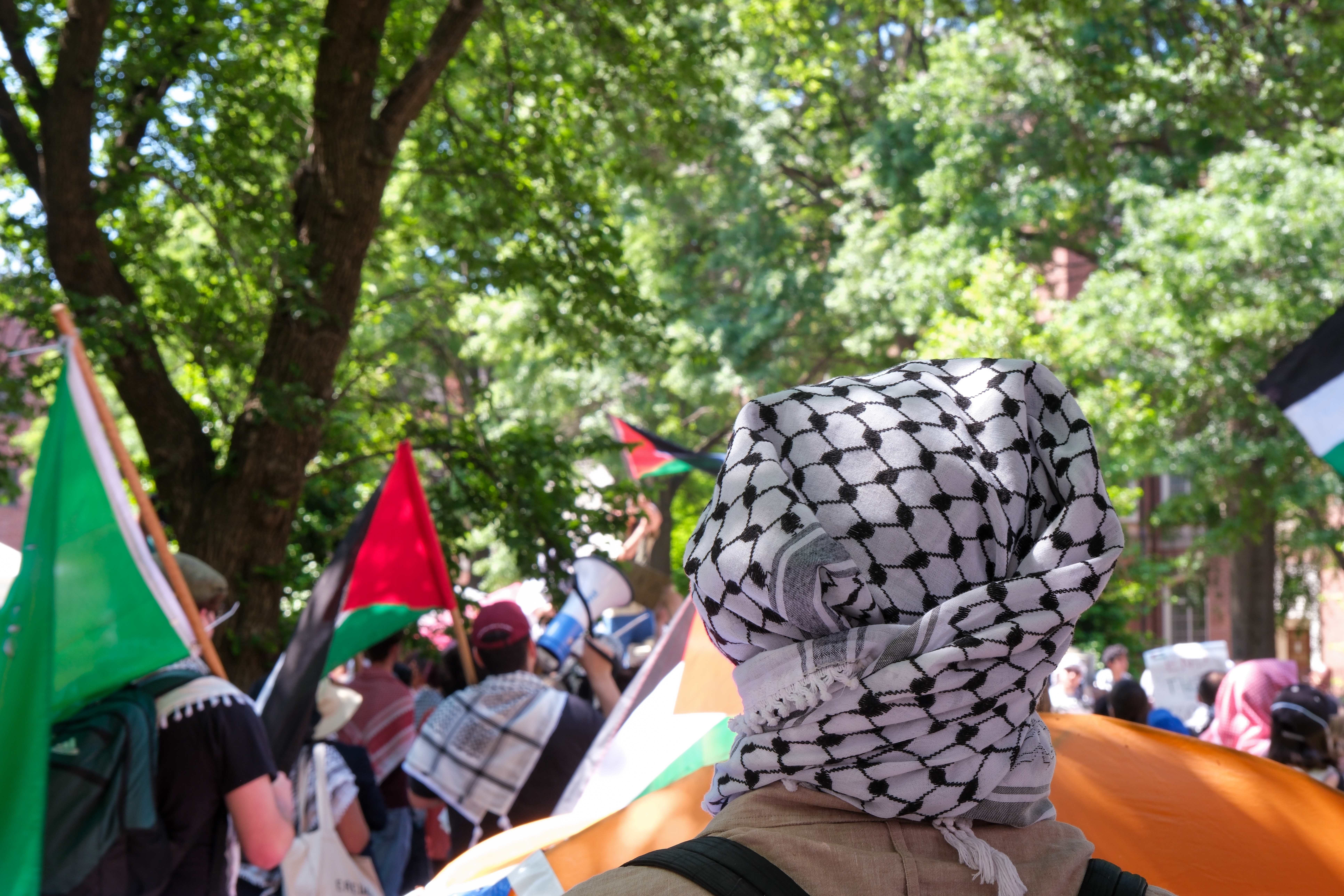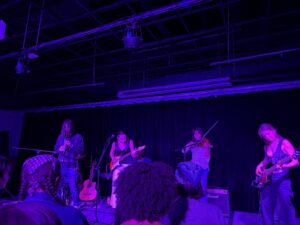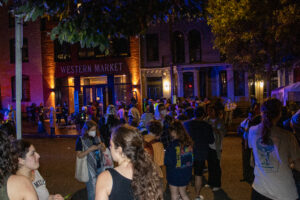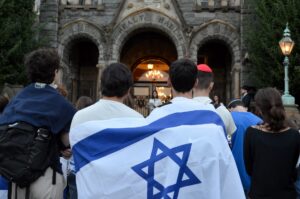For more than a week, hundreds of D.C. college students and community members have gathered at George Washington University’s (GW) Gaza solidarity encampment, drawing attention from the District, national media, and congressional Republicans.
Early in the morning of April 25, dozens of students from GW, as well as Georgetown and American University (AU), flooded into University Yard (U-Yard), a main green on GW’s campus, where they began setting up two dozen tents. Over the next week, the encampment, which protesters have named the “Popular University for Gaza,” expanded to include over 60 tents, spanning the entirety of quad, as well as the 2000 block of H Street.
Planned by the DMV Students for Justice in Palestine (SJP) Coalition, which includes students throughout D.C., the encampment protests Israel’s ongoing occupation of Palestine and its bombardment of the Gaza Strip, where the International Court of Justice has ruled that Israel “plausibly violated” the U.N. genocide convention.
Each day, hundreds of demonstrators—including students from across D.C., faculty, staff, and community members—have shown up in support. On its first day, 135 people marched from Georgetown to join the GW encampment, following a rally on the Healy steps drawing over 200 people. As much a contentious site of protest as it is a site of community, the encampment has held subsequent rallies drawing over 600 people, with some participants spending singular or multiple nights.
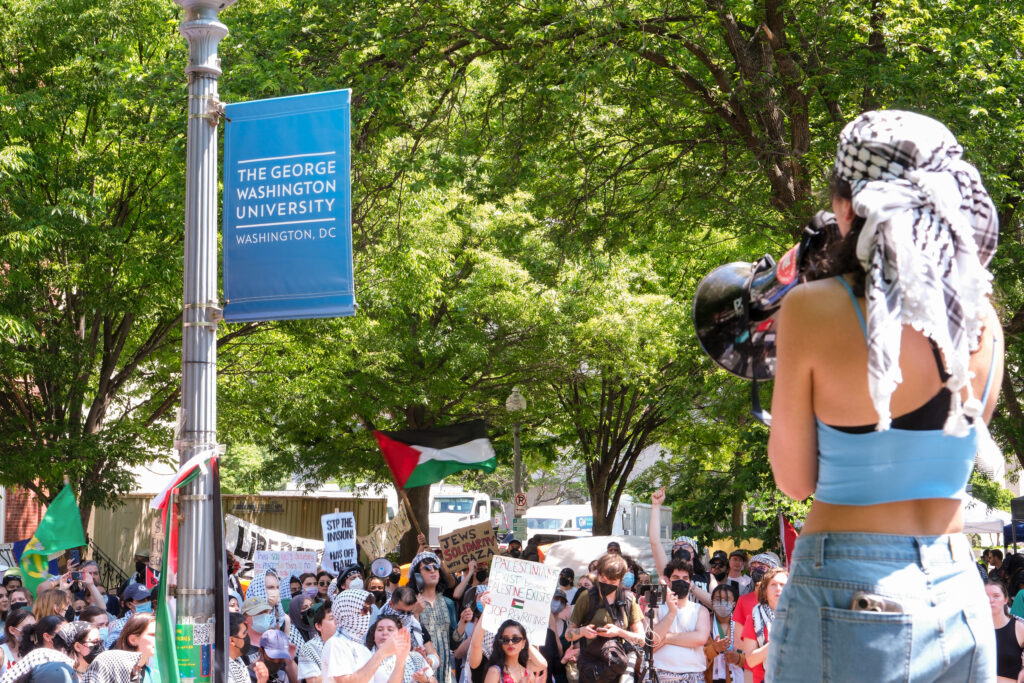 Photo by Sydney Carroll
Photo by Sydney Carroll
“It’s a community that people don’t turn their eyes away from the injustices of the world, instead people are attentive, they’re creating a community that they actually desire to be in. And I think that’s really, really beautiful,” Selina al-Shihabi (SFS ’26) said.
As the encampment enters its second week, the Voice has spoken to more than 25 student organizers, faculty members, and community members about the myriad ways they’re participating and why.
“All eyes are on Gaza”: Georgetown students demand divestment
The encampment was jointly planned by DMV SJP, which includes students from Georgetown; George Mason University; GW; AU; the University of Maryland; the University of Maryland, Baltimore County; Howard University; and Gallaudet University. Students from Georgetown have overnighted at the encampment, some since its initial day.
While each university has a different relationship to Israel and the ongoing movement for Palestinian liberation, the encampment shares a set of joint demands: public disclosure of university investments; divestment from corporations with ties to Israel; an end to all academic ties with Israeli institutions, including study abroad programs; and the protection of pro-Palestine speech, as well as the revocation of student conduct violations and suspensions of organizers.
Students emphasized that they intend to remain at the encampment until their universities engage with these demands.
Although the encampment is at GW and a coalition effort, Georgetown students participating also have specific demands for their administration. These were first outlined in a community statement delivered to President John DeGioia in February and include divestment from Alphabet and Amazon; the creation of a working group on Palestinian, Arab, and Muslim safety and inclusion; committing to protecting pro-Palestine speech; and ending the study abroad program with Tel Aviv University in favor of a PalTrek program.
Georgetown currently invests over $31 million in Alphabet and Amazon, two companies that create technologies for Project Nimbus, a cloud computing project used by the Israeli government and military. Employees at both companies have said this technology furthers the surveillance and oppression of Palestinians.
 Photo by Katie Doran
Photo by Katie Doran
“Every single one of our universities has investments in corporations complicit in this ongoing genocide,” Lela Tolajian (SFS ’26), an organizer at the encampment, said. “All of our eyes are on Gaza and that means that we are committed to stay as long as possible, as long as it takes to achieve our demands.”
For student organizers, the phrase “eyes on Gaza” has become a key tenet to their philosophy around the encampment. While their demands call for action from their respective universities, multiple protesters told the Voice that they wanted the focus to remain on Israel’s occupation of Palestine, not on themselves.
Miriam Siegel (SFS ’26), who has been at the encampment since the first morning, said in an interview with the Voice that protesters have been closely following the news coming from the Gaza Strip, including Israeli prime minister Benjamin Netanyahu’s promise to invade Rafah, a city in southern Gaza, regardless if a ceasefire and hostage deal is reached.
“We’re calling this the ‘Popular University for Gaza’ and part of that is that we’re all learning from each other; we’re all teaching each other,” Siegel said. “So, all eyes are on Gaza right now.”
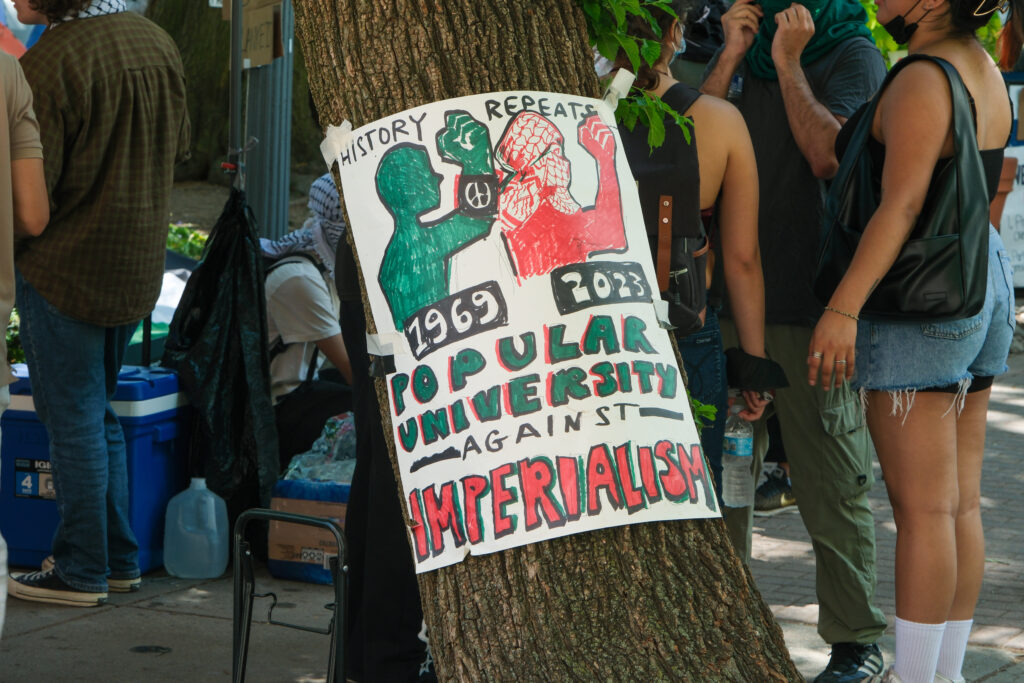 Photo by Sydney Carroll
Photo by Sydney Carroll
While they keep updated on current affairs, student protesters also aim to stay connected to the Palestinian people. Siegel said they’ve been receiving voice notes and images—many of children holding signs—from people in Gaza thanking those at GW for protesting. On multiple evenings this past week, protesters gathered together to listen to those voice notes over loudspeakers.
For many in the encampment, their connection to Gaza and its people goes beyond voice notes and social media. Many demonstrators have family in Palestine, and for them, the encampment has provided an opportunity to share space with those also similarly impacted by Israel’s invasion in Gaza.
Al-Shihabi said in an interview with the Voice that she often feels like her grief isn’t understood or validated by her peers on campus, an issue that Georgetown’s Palestinian students have been calling attention to for months. The encampment, she said, has created a space for her to feel her grief with those who share in it.
“It’s hurtful to think that people aren’t truly empathetic when it comes to the fact that I’ve lost family members and instead, some people have blatantly just said your family are casualties for the terrorists there,” al-Shihabi said. “These people don’t view my family as terrorists. These people don’t view my family as Hamas or casualties. They view my family as real people.”
Community members energized despite student suspensions and threat of MPD
On Wednesday, organizers told the Voice that demonstrators are committed to the encampment and to achieving their demands.
“The community is still really fired up about our demands. The students are fired up about our demands,” Siegel said. “We’re going to be here until those demands are met. I think that the community support we’ve seen has been absolutely outstanding. People are feeling strong and feeling good, and feeling like we’re ready to be here for a while.”
The U-Yard encampment follows similar demonstrations at other universities, including Columbia University, University of California Los Angeles, and the University of Texas at Austin, among others. Across the country, more than 2,000 protesters have been arrested at university protests for Palestine, but GW has not seen significant police intervention.
In the early morning of April 26, Mayor Muriel Bowser’s office and the Metropolitan Police Department (MPD) denied GW’s request for police to sweep the camp, as reported by The Washington Post. MPD cited worries about the optics of retaliating against peaceful protesters.
Although there has been no police action, student protesters have experienced consequences for their involvement. Seven GW students were suspended from the university for their involvement in the encampment, each receiving nine conduct violations and, as a result, losing access to their housing and meal plans.
Maria, a student organizer at GW who spoke to the Voice on the condition that she be identified only by her first name, emphasized that organizers will continue their work even if they face pushback from police and administrators.
“Fear of any repression we might face is nothing compared to living under a brutal genocide,” Maria said. “If there’s one thing that [the encampment] is proving, it’s that our commitment is strong, the power of the student movement is only growing.”
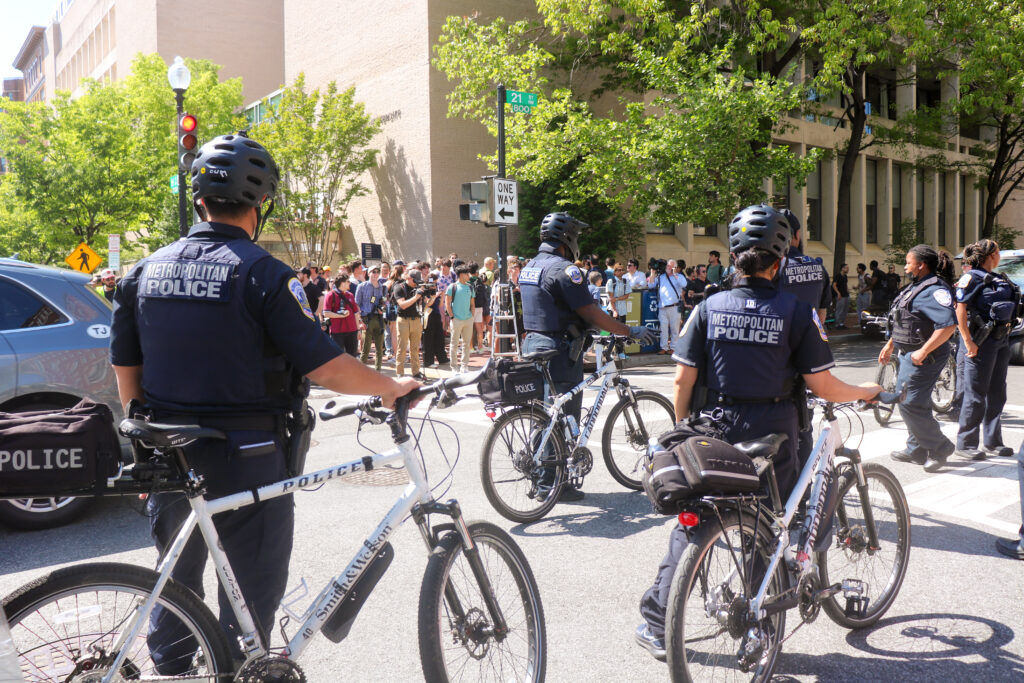 Photo by Eddy Binford-Ross
Photo by Eddy Binford-Ross
A community with an emphasis on education and accessibility
The community created by the encampment stretches far beyond the people who are actively there each day—donations of food, water, and supplies have poured in from around D.C. Organizers are now able to offer three meals a day as well as snacks to anyone at the encampment, free of charge.
“I think it’s incredible to see how much the community has come together to support this encampment every single day,” Tolajian said. “We have community members, families, restaurants, small businesses coming to bring us food and supplies if we need, and I think everyone is extremely committed.”
Volunteer medics and community safety organizers from the D.C. Peace Team and Harriet’s Wildest Dreams have also aided demonstrators in prioritizing physical safety.
Organizers have tried to center political education via teach-ins as well. Led by faculty as well as outside speakers, the teach-ins have focused on everything from Palestinian history and culture to the current war to practical skills regarding how to handle police violence.
During the day, when protesters are not chanting and listening to speeches, those in the encampment gather on the grass to talk among themselves and complete schoolwork—for many, finals begin today. There are often several students who can be seen painting signs or other art in support of Palestine. One student has been painting a piece for several days depicting two people raising the Palestinian flag above a pile of barricades, while others look on from the bottom of the canvas, wrapped in keffiyehs—a scarf, worn by many protesters, which symbolizes Palestinian culture and the struggle for a Palestinian state.
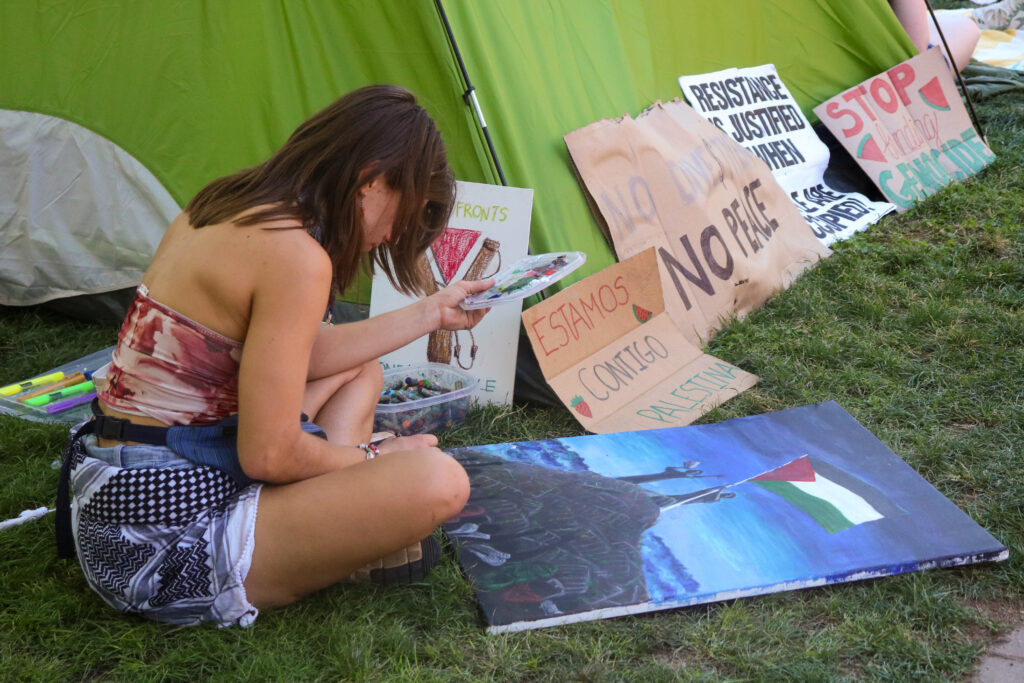 Photo by Eddy Binford-Ross
Photo by Eddy Binford-Ross
A small community garden with za’atar, lemon balm, lavender, mint, and other potted herbs and flowers has been put together at the encampment’s border. A sign above reads: “The People’s Garden, a guerilla garden to root us in the land.”
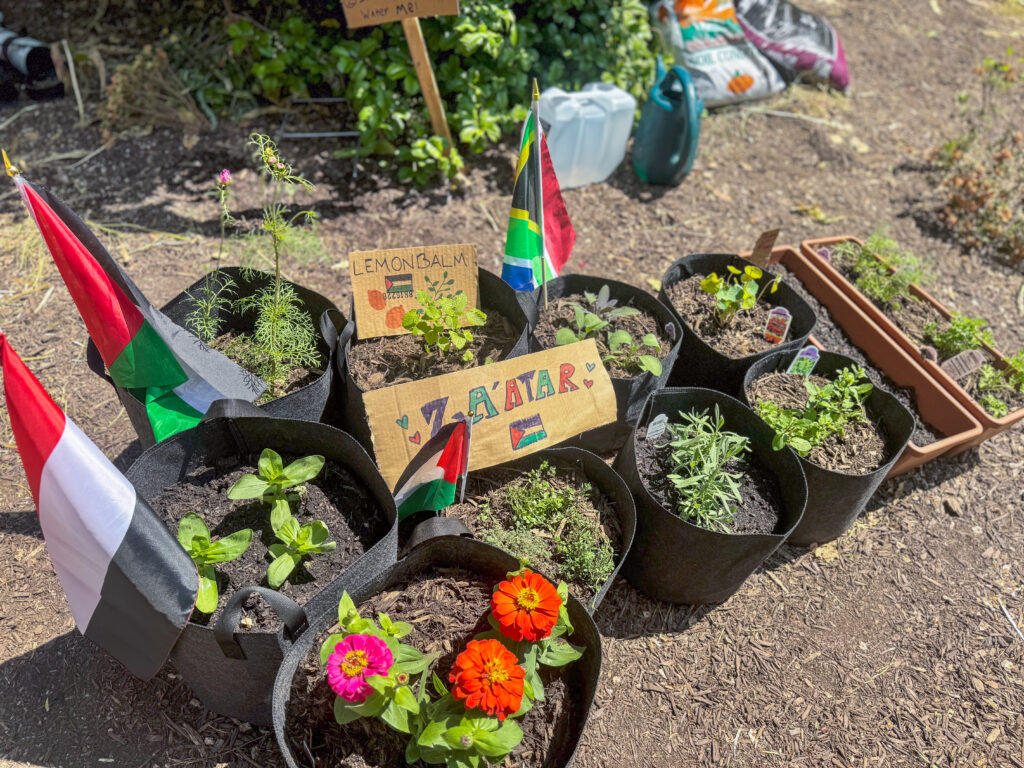 Photo by Carolina Bomeny
Photo by Carolina Bomeny
One of the tents has been transformed into a community library as well—named after Refaat Alareer, a famous Palestinian poet and activist who was killed by an Israeli airstrike in December. The library includes a wide variety of donated books, ranging from those about Palestinian history and culture to novels and literature unrelated to Palestine.
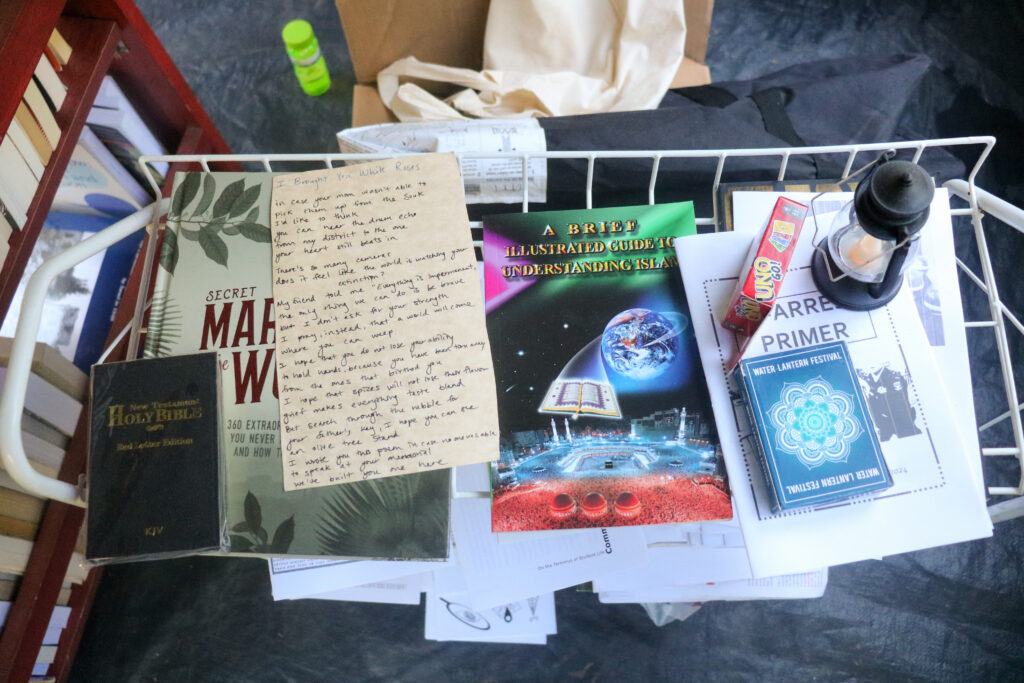 Photo by Eddy Binford-Ross
Photo by Eddy Binford-Ross
“We have a lot of political education going on. We need to understand the conditions that are being imposed on us,” Maria said. “The best thing that we can do is commit to learning, and commit to growth, and commit to showing up for each other.”
The protests also hold space for a variety of religious practices. Five prayers are hosted daily for Muslim students, with prayer mats set out in the yard. For Jewish students, many of whom were celebrating Passover while at the encampment, Shabbat dinners have offered a gathering space.
Accessibility with regard to disability as well as faith is also a consideration for some protesters. Elliot L. (SOH ’24), who spoke to the Voice on the condition that his last name not be shared, said that the community at the encampment has made it possible for him, as a wheelchair user, to safely attend the protest.
“The community here has made sure that I could get up and down the curbs, that I can get everywhere I need,” Elliot L. said. “I’m actually just feeling really, really supported by the community here in terms of being at this protest, as a wheelchair user.”
Faculty participate in encampment, stand in solidarity with students
The encampment has also drawn faculty members from many participating universities, who hope to protect their students as well as advocate for their demands.
“We’ve seen what’s been happening in other parts of the country, and I think as faculty, it’s really important to us that our students are safe,” Elisabeth Anker, a GW faculty member, said. “Protests and counterprotests are part of First Amendment freedoms, and it’s part of the dialogue that the students are trying to have here. And so any way that we can have that being done in a safe way is important for democracy.”
For other professors, their fields of study inform their involvement in the protests.
“I teach Asian American history,” Crystal Luo, a Georgetown faculty member in the history department, said. “May is AAPI History Month, and Asian American Studies started with student protests like these, and I feel like I’d be doing a disservice to the field if I didn’t show up.”
At times, including on the first day, Anker and other faculty members have formed a human chain around demonstrators to protect students when they have anticipated police or counterprotester intervention.
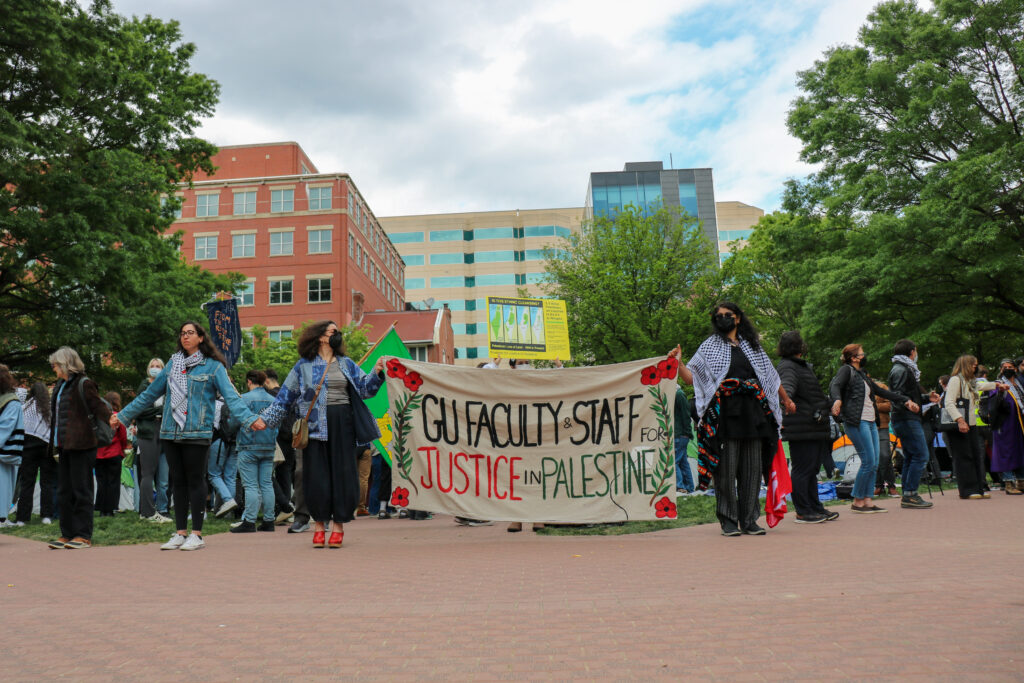 Photo by Eddy Binford-Ross
Photo by Eddy Binford-Ross
Throughout the week, there has been a consistent, but small contingent of counterprotesters present, many holding Israeli flags. Only once has this resulted in physical confrontation, when, on the first day, police escorted a counterprotester away who yelled “terrorism” and pushed a demonstrator.
Rahma Abdallah (SOH ’27), an organizer behind the encampment, said that having a coalition of schools at one encampment has also helped build community and ensure safety.
“We’re trying to amplify the people who have also been facing the most oppression,” Abdallah said. “So just making sure that we’re consolidating all of our efforts into one campus, as opposed to, like, scattered little encampments—it’s a way for us to keep each other safe, keep ourselves safe, and just amplify the message as best as possible, as a unified front.”
While encampments as well as clashes between protesters, counterprotesters, and police in the U.S. have received immense media coverage, Siegel emphasized that the goal of the demonstrations is to redirect focus to Gaza.
“We are not the story. The story is what’s going on in Gaza. We really hope here that as much as the media is covering what’s going on in these encampments around the country, that they’re putting more focus on the genocide that’s going on in Gaza.”
Franziska Wild, Connor Martin, Katie Doran, Graham Krewinghaus, Nora Scully, and Cole Kindiger contributed reporting.


